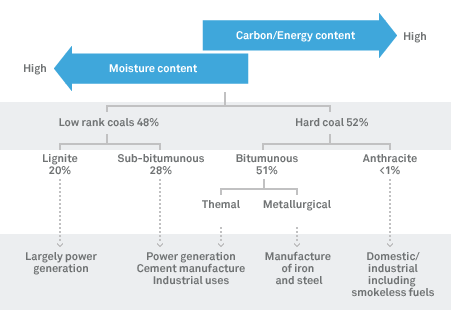Coal Specific
Coal is the most abundant on the planet, the broadest geographic distribution of fossil fuels. According to the assessment of the World Energy Council, to the end of 2006, the world's total recoverable resources of fossil fuels 66.8%.

2007 global consumption of 3177.5 million tons oil equivalent of coal, total global primary energy consumption of 28.63% Coal is not only used as power generation, but also steel, cement production as well as other industrial activities, the necessary fuel. With the long-term economic development, increasing demand for coal
Low rank coals, such as lignite and sub-bituminous coals, are typically softer, friable materials with a dull, earthy appearance; they are characterised by high moisture levels and a low carbon content, and hence a low energy content. Higher rank coals are typically harder and stronger and often have a black vitreous lustre. Increasing rank is accompanied by a rise in the carbon and energy contents and a decrease in the moisture content of the coal. Anthracite is at the top of the rank scale and has a correspondingly higher carbon and energy content and a lower level of moisture.
Coal Types
Geologists also classify coal types according to the organic debris, called macerals, from which the coal is formed. Macerals are identified (microscopically) by reflected light - the reflective or translucent properties of the coal indicating the individual component macerals and the way they have combined to form the coal.
Bituminous coals are dense black solids, frequently containing bands with a brilliant lustre. The carbon content of these coals ranges from 78 to 91 percent and the water content from 1.5 to 7 percent.
Sub-bituminous coals usually appear dull black and waxy. They have a carbon content between 71 and 77 percent and a moisture content of up to 10 percent and are used for electricity generation or can be converted to liquid and gaseous fuels.
Brown coals, found in Australia in Victoria's Latrobe Valley, are used for power generation but generally are uneconomic to transport because of their high moisture content. These coals are also susceptible to spontaneous combustion.
- Coal Mining
- |
- Coal Crusher
- |
- Coal Mill
- |
- Coal Classification
- Privacy Policy | © 2010 - 2011 SHANGHAI SHIBANG MACHINERY CO., LTD.
